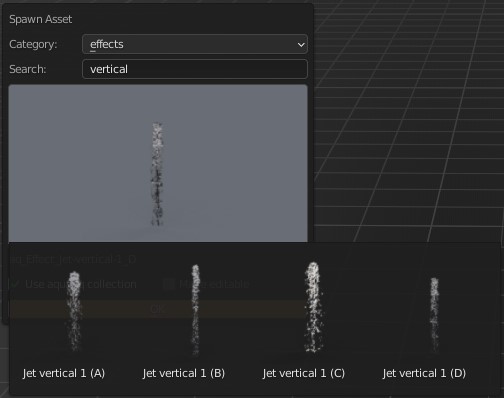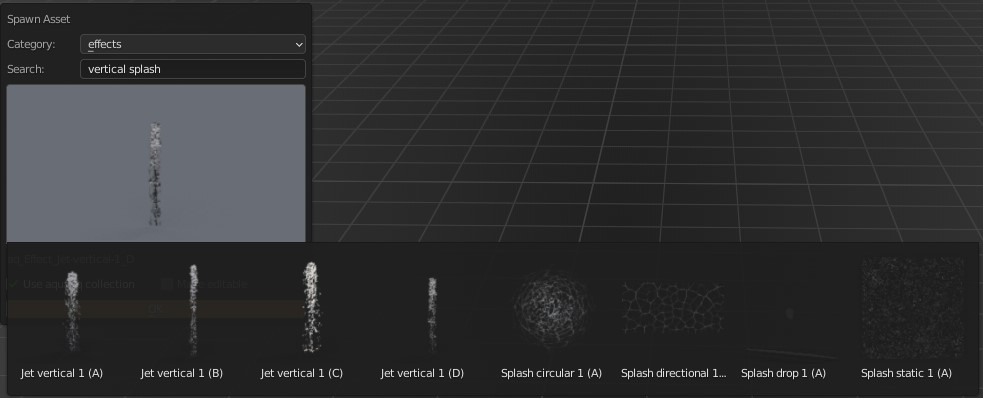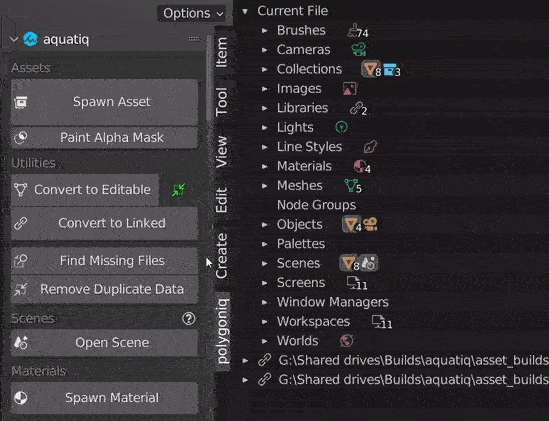Spawning & Manipulating Assets¶
This section describes spawn asset in detail, concepts of filtering, how we name
things, how Convert To Linked and Convert To Editable can be used in your scenes to maximize
efficiency and asset related features that we ship in aquatiq.
Spawn Asset¶
Spawn Asset button can be used to spawn a single asset. The model will always spawn at the current
3D cursor location.
Spawn Asset Dialog¶

Asset to be spawnedis the main part of the user interface. It is a preview image representing the asset that will be spawned after clicking theOKbutton. If you want to spawn another asset click on the image and a list with all assets fitting your filter will appear.Full nameis the name of the assets with the prefix and suffix. This additional information can be used in the Search bar.Make editablecheckbox. When checked the asset is appended to the scene, otherwise, linked instances will be created. We recommend having this option disabled to save memory. It is possible to make assets editable afterwards. For more information read Convert To Editable section.Use aquatiq collectioncheckbox. When checked the asset will be placed in a category collection under aaquatiqcollection. If the collection does not exist, it will be created. This makes all of aquatiq content end up in one place for your convenience.
Filters¶
Assets can be filtered by provided text input provided by the user.
Search¶
Use this field to search for a model by keyword. For example, if you write the keyword vertical
only vertical effects will show up in search. This is a quick way of getting the asset if you know
what you are looking for and don’t want to scroll through all assets.

Multiple keywords
Search filters can take multiple words split by Space for more complex queries. You can use
search filter jet splash and all jet effects and splash effects will be displayed.

Category¶
aquatiq assets are sorted into multiple categories according to their type.
Only assets from selected categories will appear in the assets to be spawned. All other filters
apply after this one. You won't find effects in fountain category.
Editable & Linked Assets¶
Objects in aquatiq can be in two states. Either linked or editable. Linked
objects save memory and are easily updatable. On the other hand editable objects can be customized
to your liking. aquatiq assets should get nice render results out of the box, thus
linked variant should be used in most of use cases.
Optimization tip
We have a complete section that describes benefits of using linked assets on the advanced topics page.
Limitations of linked assets
Linked assets are limited in terms of customization. There are only a few attributes that we can feed into shaders. The amount of data will always be limited. We try to choose a commonly used customization and support that even on linked assets. Keep in mind that for bigger changes you will have to convert to editable.
Convert To Editable¶
This button converts selected objects to editable and makes them local to the scene. This way you
have complete control of the objects, you can change the mesh, textures, materials, apply custom
modifiers, animations, etc. On the flip side, this affects the performance of the scene so use this
function wisely.

Convert To Linked¶
This button converts selected objects back to their linked variants. Works only on polygoniq
assets because we know where we can locate the original variant. Doesn't work on particle systems.
Destructive operation
Converting to linked can be destructive. All local modifications to the asset will be
removed (mesh changes, materials changes, animations) and the default aquatiq
asset is going to replace the existing one!
Asset Manipulation Features¶
aquatiq is shipped with features that improve default Blender workflow and are
ready to use in the panel at hand.
Open scene¶
Opens an aquatiq showcase scene. Great to getting know the aq_Water_Ocean and
aq_Water_Shorline materials. Click here to get water shaders documentation.
Spawn material¶
Spawns a water material in the selected object.
Volume of materials
aquatiq water materials need objects with volume to work correctly. When spawning on a object without a volume you will get a warning.
Utilities¶
Following section describes utility features that can minimize the duplicates in your file or help you with resolving issues.
Remove Duplicate Data¶
Having multiple editable assets can result in many duplicated materials, node groups or textures
that reference the same things. Duplicate data are indicated with the .001, .002, ... suffixes.
Remove Duplicate Data button merges all duplicate data into one datablock
(data deduplication). This applies to materials, node groups and textures.
Optimization tip
Having less materials, node groups and textures results in smaller .blend file sizes, saves
memory, bandwith and makes your scenes clean.

Automatic deduplication checkbox
If checkbox located next to the Convert To Editable button is checked in then data
deduplication is done automatically for each aquatiq asset converted to editable.
Find Missing Files¶
Looks for missing files in the aquatiq installation path you have set in preferences. Quick way to fix broken references to images, materials, collections or other aquatiq related datablocks.
Missing models
If you are missing models (collection datablocks) you need to Save and Revert (reopen) the
.blend file in order to reload them back into the scene.
Missing Files can't fix everything
Find Missing Files can't solve everything. There are certain cases when it is necessary to
respawn the asset or fix the paths manually (advanced). This can mostly happen when there was
a major update to the naming of the assets, textures or related. But firstly please make sure
that the aquatiq installation is valid.